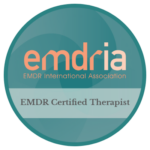Eye Movement, Desensitization, and Reprocessing (EMDR)
What is EMDR Therapy?
The purpose of the eight-phase EMDR therapy is to help liberate a client from the past into a healthy and productive present.
EMDR Therapy brings together aspects of many major psychological orientations: the attention to etiological events underscored by psychodynamic therapy, the conditioned response highlighted by behavioral therapy, the beliefs of cognitive therapy, the emotions of experiential therapies, the body sensations of somatic therapies, the imagery work of hypnotic therapies, and the contextual understanding of system’s theory. ~Francine Shapiro, Eye Movement Desensitization and Reprocessing (EMDR) Therapy, Third Edition.
EMDR Therapy is an evidence-based psychotherapy for Posttraumatic Stress Disorder (PTSD). In addition, successful outcomes are well documented in the literature for EMDR treatment of other psychiatric disorders, mental health problems, and somatic symptoms. The model on which EMDR Therapy is based, Adaptive Information Processing (AIP), posits that much of psychopathology is due to the maladaptive encoding of and /or incomplete processing of traumatic or disturbing adverse life experience. Any event that has had a lasting negative effect on the self or psyche is by its nature “traumatic” (Shapiro, EMDR). This impairs the client’s ability to integrate these experiences in an adaptive manner. The eight-phase, three-pronged process of EMDR Therapy facilitates the resumption of normal information processing and integration. This treatment approach, which targets past experience, current triggers, and future potential challenges, results in the alleviation of presenting symptoms, a decrease or elimination of distress from the disturbing memory, improved view of the self, relief from bodily disturbance, and resolution of present and future anticipated triggers.
Utilizing an 8 Phase Protocol, EMDR Therapy explores the History of a trauma or wounding, introduces Resources for managing emotional elevation, isolates a particular Target image or felt sense that is tied to a Negative Cognition (a self-statement that is not true but feels true) and introduces a new Positive Cognition (a self-statement that is life-giving), utilizes Bilateral Stimulation using eye movements, tactile stimulation or audio stimulation in order to connect the left hemisphere thinking brain and the right hemisphere healing brain for reprocessing the traumatic or wounding moment(s).
For more information on EMDR go to www.emdria.org
Who can benefit from EMDR therapy?
EMDR therapy helps children and adults of all ages. Therapists use EMDR therapy to address a wide range of challenges:
- Anxiety, panic attacks, and phobias
- Chronic Illness and medical issues
- Depression and bipolar disorders
- Dissociative disorders
- Eating disorders
- Grief and loss
- Pain
- Performance anxiety
- Personality disorders
- PTSD and other trauma and stress-related issues
- Sexual assault
- Sleep disturbance
- Substance abuse and addiction
- Violence and abuse

